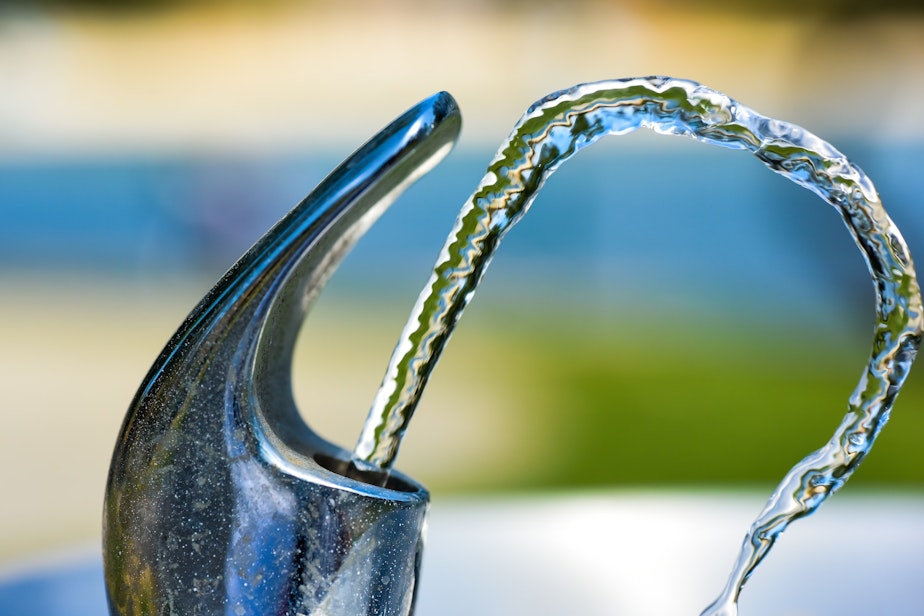How beverage battles undermined the tap and gave rise to bottled water

Dip into almost any grocery or convenience store, and you’ll have your pick of at least a dozen different brands of bottled water.
But despite being so ubiquitous in American culture today, the meteoric rise of bottled water isn't by coincidence and the average bottle and average tap have more in common than you might think.
"I'm old enough to remember growing up in public school, in Seattle, in the late '70s and '80s — a moment at which there was essentially no such thing as the product of single-use, plastic, bottled water," says Daniel Jaffee, associate professor of Sociology at Portland State University and author of the recent book, "Unbottled: The Fight Against Plastic Water and for Water Justice."
During the time of Jaffee's childhood, Americans consumed only two gallons per capita of bottled water. At the supermarket, options were essentially limited to Perrier in large glass bottles. But fast forward to today and the picture looks very different: Americans on average consume 47 gallons of bottled water per person per year.
All in all, 20% of people in the United States today get plain water from a bottle, completely shunning the tap.
So what accounts for that shift?
"Certainly marketing that focuses on everything from health and fitness to youth... but also marketing that has cast doubt, subtly or overtly, about the safety and the quality of public tap water," Jaffee said. "The critics of the industry call this a war on tap water."
Sponsored
For the last four to five decades, the U.S. has seen a federal divestment in public water systems, leading to a fiscal crunch on local utilities. That divestment, coupled with viral images of toxic water systems in towns like Jackson, Mississippi, has led to a growing perception that tap water is becoming unsafe.
But Jaffee says that by and large, tap water is safe.
"Despite these dramatically growing fears — and significant percentages of the population are concerned about their tap water safety — the vast majority of public tap water in the United States remains safe to drink and meets all federal safety standards," he said.
In any given year, 7-8% of water systems in the U.S. have one health-related violation of the Safe Drinking Water Act, the main federal guideline for water safety, Jaffee said. But concerns are growing as funding dips and a deferred maintenance crisis is building nationwide.
Jaffee said it would cost $3 trillion over the next two decades to bring public water systems back up to snuff. And communities that need that updated infrastructure the most — particularly low-income communities and black and Latino communities, both urban and rural — are frequently being pushed to rely on the expensive alternative of bottled water.
Sponsored
In Flint, Michigan, a lack of funding for public water systems has led to an ongoing water crisis, with local tap water being too dangerous to drink and leading residents to use bottled water for essentials like cooking and showering.
To make matters more complicated, tap water and bottled water are regulated by two different agencies, leading to two different standards for water safety.
The Environmental Protection Agency (EPA) oversees tap safety, and requires public utilities to routinely test water for contamination. The Food and Drug Administration (FDA) oversees the safety of bottled water, and while the FDA does inspect bottling plants, Jaffee said inspections have declined in recent years.
What's more, many mainstream companies actually use tap water to fill their bottles.
Just over one-third of the bottled water on store shelves actually comes from groundwater or natural spring water; the rest is refiltered tap. So as demand for bottled water continues, whether by necessity or public perceptions of safety, bottling companies are coming into direct competition with public utilities for water access.
Sponsored
"It really is a precious public good, and it's a public good," Jaffee said. "The concern is that if we move toward market control over a substance that's essential for life, access to it then becomes based on the ability to pay. And we know that some people will inevitably go without, and in the case of drinking water, that can be deadly."
Listen to the full conversation with Daniel Jaffee, including a local legal battle over a Nestle Bottling plant in Cascade Locks, Oregon, by clicking "play" on the audio icon at the top of this story.





